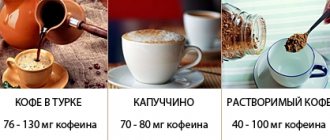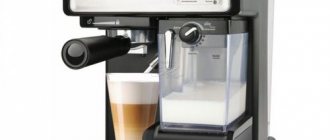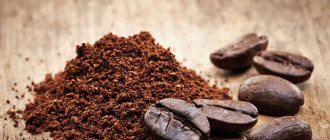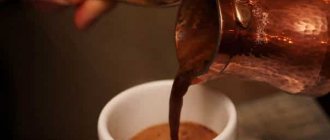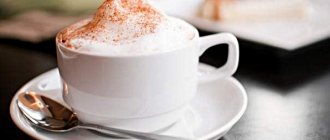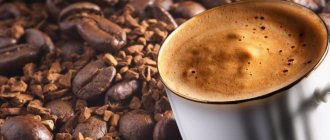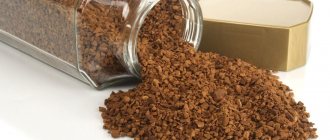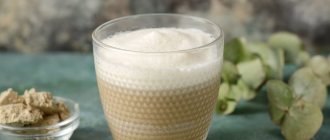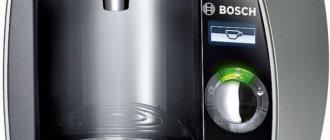Coffee is a tasty and aromatic drink that is very popular all over the world. Traditionally, roasted coffee beans are ground independently in a coffee grinder and prepared in a Turk. This process of preparing a hot drink allows you to preserve maximum taste and aroma, but it also takes a lot of time. A much easier and faster way to brew delicious coffee is to use a coffee machine.
Add coffee beans
This technologically advanced unit successfully replaces the Turk, and some models even replace the coffee grinder. The coffee machine retains all the aroma and rich taste of natural coffee, and anyone can use it, without special knowledge and skills. All coffee machines are sold complete with comprehensive instructions that reveal all the capabilities of the machine. Despite this, many people are concerned about the question “How much coffee should I pour into a coffee machine and is it possible to reduce this figure?”
Pour coffee into a cone
Benefits of using a coffee machine
Having a coffee machine at home allows you to save free time and gives you the opportunity to prepare an invigorating drink according to the best international standards right in your kitchen. The main thing for making delicious coffee is to choose the right model of coffee machine, and learn to calculate the optimal coffee consumption in the coffee machine for 1 serving.
Some people prefer a strong drink, while others just like the aroma, but the strength seems unnecessary. For this reason, it is difficult to name the exact amount of ground coffee, especially since this figure may differ for different machines. The best solution is to purchase a high-quality coffee maker with detailed instructions. As a rule, it indicates options for preparing coffee of various strengths.
Delonghi
Experienced baristas recommend paying attention to brands such as Saeco and Delonghi. These manufacturers have proven themselves on the positive side, as evidenced by numerous positive customer reviews.
How much ground coffee is needed per serving?
When purchasing a coffee machine, buyers are faced with the question of how much ground beans are needed for one serving. The instructions for the device will probably contain recommendations, but if the auxiliary book is lost, do not be upset, because there are generally accepted standards. Over time, you can adjust the values according to your preferences through trial and error.
Flavored drink
The coffee consumption per serving in a carob-type coffee machine is 6-8 grams. Therefore, from one average pack weighing 250 grams, you will get about 40 servings of an aromatic and invigorating drink.
If we take an espresso drink as a comparison, then one serving will require only 7 grams of ground beans. This is approximately one level teaspoon. However, it is worth considering that the weight of coffee depends on its grinding.
In cases where the coffee maker is equipped with a mill, it is enough to take one large spoon of the grain product to get a cup of an invigorating drink.
Real coffee
The coffee machine comes with a measuring spoon. If you didn’t have it, you can purchase it separately at a specialty store. But in any case, you can do without this tool. Baristas recommend using the following measurements:
- in one tsp. the top holds 6 grams of ground coffee;
- in one tsp. without top – 4 grams;
- in one article l. with top – 16 grams;
- in Art. l. without top – 10 grams.
For those who use capsule machines, the problem of measuring the required amount of coffee simply does not exist, since one capsule is used to prepare 1 serving of the aromatic drink.
Manufacturing Features
If the espresso making process is carried out in a coffee machine, the recommended dose is on average 7 g, but keep in mind that you will end up with 30 ml of drink. Using 6 grams of raw materials to make Turka, per 60 ml of fragrant and tasty coffee. In a French press or coffee pot, the recommended dose of powder is 10 g per 200 ml of water. A similar procedure for making a drink in a coffee maker will require from 6 to 9 grams of ground beans. All the given numbers are quite arbitrary, since each connoisseur prepares coffee according to his personal preference.
To accurately maintain the dose, it is recommended to use a special measuring spoon or cup. In their absence, it is possible to get by with ordinary cutlery, adhering to the following characteristics:
- A teaspoon – 4 or 6 g (heaped) of ground coffee;
- A tablespoon – 12 or 17 g (heaped).
How much coffee is recommended to consume per day?
Lovers of coffee drinks should not forget that this is a stimulant that has an effect on the entire body, and mainly on the cardiovascular system. Doctors recommend strictly limiting the amount of coffee consumed per day.
Capsules for coffee machine
For a healthy person, 500 ml of a medium-strength drink per day is enough. Naturally, if we are talking about espresso, then the maximum permissible amount of drink per day should not exceed 150 ml.
How much energy does a coffee machine consume?
The manufacturer of Jura coffee machines states that the energy consumption of their equipment is 4–30 W/hour, depending on the model. For example, the Jura Micro 1 consumes only 4W/hour at a power of 1350W (a heating element that works for just a few seconds to reach the appropriate temperature), and the Jura Giga 9 consumes 30W/hour at a power of 2300W. The declared consumption takes into account a regular coffee machine without energy savings. Accordingly, to prepare one or two cups of coffee you will need only 5-10 minutes, including making cappuccino. We are even too lazy to count how much you will spend at home to make 3-4 cups a day, 15 kopecks?!
How to reduce coffee bean consumption without compromising the quality of the drink
Some housewives are interested in how to reduce the consumption of coffee beans in a coffee machine to prepare one cup of coffee. The answer to this question lies in the type of coffee maker you use:
- It will not be possible to reduce the coffee consumption per cup in a capsule-type coffee machine, since the required amount of product is already contained in one capsule.
- In carob coffee makers, you can reduce consumption if you use a measuring spoon while preparing the drink.
From the outside it may seem that saving 1-2 grams is insignificant, but if you calculate how much extra is spent during the week, month and year, then the advantages of using a measuring spoon become obvious. At the same time, reducing the daily amount of coffee by 1-2 grams will not affect the taste and aroma of the drink.
Wonderful coffee
In fact, the quality characteristics of the drink are influenced by the selected beans and the coffee machine itself. To get delicious coffee, you need to choose trusted producers who have earned the trust of customers. As a rule, such brands offer a wide range of devices in different price ranges, differing in their characteristics, options and design, so each person can choose a device according to personal preferences.
Comments (9)
I apologize, but the question at the end of the article is a little stupid, naively childish: “Yes, and be sure to ask yourself another question: why is there 7-8 grams of natural coffee per serving, and only 2 grams of instant coffee? Perhaps this is a reflection of the difference in quality. "
- It’s amazing how you can put such an answer to your own question without being a child. After all, it is clear that instant coffee contains ersatz, a concentrate, an extract from brewed coffee. And all the cake, all the solid particles that remain in the brewer (Turk for example), or in the cup - after all, this cake makes up 90% of the weight of natural coffee - this is not present in instant coffee, this is 90% of the weight. Therefore, instant coffee is 2.5 grams per serving, and ground coffee is 8 grams, and I would say even more. That’s why there is such a difference in weight, because of the cake, and in my opinion, this is understandable to a child. And here such a childishly stupid conclusion disgraces the entire article, it’s somehow awkward to read.
.
We have already written about the benefits of moderate coffee consumption so many times that we have managed to get hooked on this excellent drink ourselves, and get you hooked on it, dear reader. True, good coffee is quite an expensive thing and punches, if not a hole in the monthly budget, then at least gives it a slight crack. How to reduce expenses and not give up your favorite drink?
A study by the Roskachestvo organization came in handy here, which, together with employees from ICRT (International Consumer Research and Testing) - an international association for consumer testing and research on product properties, conducted a study of about 30 coffee machines, comparing the pros and cons of capsule and automatic machines. The organization’s specialists also calculated how much money you and I spend on coffee per year, using an automatic or capsule coffee machine or buying coffee in an average coffee shop at the rate of 1 cup of coffee per day.
Whatever one may say, visiting coffee shops every day is the most expensive opportunity to enjoy a drink. About 43,800 rubles - this is how many times a year it flies out of our pockets for cappuccino and espresso at a cafe table. The second place in terms of costs is occupied by an automatic coffee machine. The machine itself will cost you 50,000 rubles, coffee beans - on average 2,555 rubles per year, and the cost of energy consumption by the machine - another 730 rubles once a year. In total, 365 cups of coffee when using an automatic coffee machine will take 53,285 rubles out of your wallet in the first year, and 3,285 rubles each in the next.
And our rating is rounded off by coffee from a capsule coffee machine. Taking into account that to make 1 cup you need to use 1 ready-made capsule, 365 capsules of coffee will cost you and me approximately 16,425 rubles, energy consumption - 730 rubles per year. With all this, the capsule coffee machine itself costs even less than a machine - about 10,000 rubles. In total, in the first year of using a capsule coffee machine we pay about 27,155 rubles, and in the next year – 17,155 rubles. Ready to choose? Here are for you the exhaustive results of independent comparative research on capsule and automatic coffee machines conducted by Roskachestvo.
Specialists in one of the best testing centers in Europe prepared over 2.5 thousand cups of coffee - approximately the same amount of coffee that a person drinks in 2.5–3 years, drinking two cups a day. For testing, 200 kg of pure Arabica coffee and a thousand capsules were purchased, which were prepared on each of the presented samples. About 30 automatic and capsule models present on the Russian market under the brands Bosch, Delonghi, Philips, Miele, Melitta, Krups, Siemens, Jura, Saeco were subjected to laboratory tests. Testing was carried out on 20 fronts and took into account more than 90 characteristics, including production speed, temperature and quality of the purchased drink, ease of use and energy consumption. In addition, experts assessed the dynamics of the properties of the drink - whether the quality of the first and 50th cup of coffee, prepared on the same machine, differs.
According to the results of a study of coffee machines, the highest result in the overall rating was shown by the automatic machine DeLonghi PrimaDonna Elite. In addition, the list of the best included the automatic Jura with the E8 model and the capsule Delonghi EN80.B Inissia. The lowest ratings were given to the automatic Saeco Minuto HD8763/01 Cappuccino, Melitta Caffeo Passione OT Silver F53/1-101 and Miele CM 6310 OBSW.
The most delicious espresso is prepared by capsule coffee machines. According to the test results, the top 10 in terms of espresso properties consists of 60% capsule coffee machines and 40% automatic ones. But the top three favorites were completely occupied by Krups capsule coffee machines. These are models Krups XN1001 Inissia, Krups XN 3005 NESPRESSO PIXIE, also Krups Pixie XN300D. An expert group consisting of 30 organolepts tasted coffee in isolated rooms, obtaining impersonal standards of the prepared drink. After tasting the coffee, experts rated the prepared coffee on a five-point scale based on the following indicators: color saturation of the foam, smell, degree of roasting of the beans, bitterness, richness of taste.
The fastest cars are capsule ones. Among them, Krups XN 3005 NESPRESSO PIXIE, Krups Pixie XN300D and Delonghi Nespresso Lattissima EN550 are in the lead by a small margin. B. All capsule coffee machines tested also received top marks for energy efficiency.
When it comes to an automatic coffee machine, fast doesn't always mean great. After all, the time must be sufficient for extraction to occur, in other words, the transfer of caffeine and essential oils into the water. For a 40 ml cup of espresso, this is 22.5–27.5 seconds. If you take too long, the coffee will become very bitter, and if you rush, the drink runs the risk of being undercooked.
The most comfortable coffee machine is automatic. In the top 10 for this indicator there are 8 automatic ones and only 2 capsule ones. The Jura E8 is in the lead. Capsule devices also made up the top three less comfortable devices. We are talking about Krups Drop KP3505, Krups Drop KP350B and Delonghi Pixie clips EN126. A similar assessment is associated with the average score of capsule machines in terms of convenience and washing time: the common belief that washing a capsule coffee machine takes less time than an automatic one has not been confirmed.
At the same time, capsule devices have become favorites in terms of ease of use and storage. They are even less demanding and take up less space than automatic coffee machines. But operating instructions for capsule machines are less comfortable than automatic machines. The controls for them are often unclear or incomplete. The control panels of the capsule coffee machines studied, as demonstrated by professional assessments, are also far from flawless.
The thickest cappuccino foam is made by automatic coffee machines. The top three favorites were the Delonghi Prima Donna Elite slot machines; Jura E8 Platina; Siemens TE607203RW. Capsule coffee machines close the last lines of the rating for this position. During the testing process, milk of medium fat content was used - 1.5–2.5% (it was taken straight from the refrigerator, where it was stored at a temperature of 4 °C in glass glasses). The correct foam temperature is 71 °C. Models that prepared the foam at a higher temperature received lower scores, because the milk in them could burn or boil.
How many cups of coffee are there in 1 kg of beans?
report a violation
Everything depends on what strength you like your coffee. Let’s take into account that one teaspoon (teaspoon) contains 5 grams of coffee. Then, if you like strong coffee, divide 1000 g by 10 g (2 spoons), you get 100 cups. Medium strength - 1000 g divided by 7.5 g (1.5 spoons), you get 133 cups. Weak coffee - 1000 g divided by 5 g (1 spoon), you get 200 cups.
How to save 40 thousand on coffee?.
Roskoshestvo, together with employees from ICRT (International Consumer Research and Testing), an international association for consumer testing and research on product properties, conducted a study of about 30 coffee machines, comparing the pros and cons of capsule and automatic machines.
The organization’s specialists also calculated how much money a Russian would spend on coffee per year, using an automatic or capsule coffee machine or buying coffee in an average coffee shop at the rate of 1 cup of coffee per day.
So, on average, an automatic coffee machine will cost the consumer 50,000 rubles, coffee beans - on average 2,555 rubles per year, and the cost of energy consumption by the machine - another 730 rubles per year. In total, 365 cups of coffee using an automatic coffee machine will cost the consumer 53,285 rubles in the first year, and 3,285 rubles in the next.
The coffee itself, prepared on a capsule coffee machine, turns out to be somewhat more expensive, taking into account that to make 1 cup you need to use 1 ready-made capsule. On average, 365 coffee capsules will cost the consumer 16,425 rubles, energy consumption – 730 rubles per year, and the capsule coffee machine itself is very cheaper than a machine – about 10,000 rubles. In total, in the first year of using a capsule coffee machine, a Russian will pay about 27,155 rubles, and in the next year - 17,155 rubles.
A more expensive method is to buy coffee every day at an average coffee shop. Once a year, a Russian spends about 43,800 rubles.
So that consumers are able to make an informed choice in favor of the coffee machine model that fits into their personal budget and has the features necessary for the user, Roskachestvo presented a comparative rating of coffee machines.
Specialists in one of the best testing centers in Europe prepared over 2.5 thousand cups of coffee, approximately the same amount of coffee that a person drinks in 2.5–3 years, drinking two cups a day
. For testing, 200 kg of pure Arabica coffee and a thousand capsules were purchased, which were prepared on each of the presented samples. About 30 models present on the Russian market under the brands Bosch, Delonghi, Philips, Miele, Melitta, Krups, Siemens, Jura, Saeco were subjected to laboratory tests. The study included both automatic and capsule coffee machines; the comparative rating allows consumers to make a personal choice based on personal preferences.
Testing was carried out on 20 fronts and took into account more than 90 characteristics, including production speed, temperature and quality of the purchased drink, ease of use and energy consumption. In addition, experts assessed the dynamics of the properties of the drink - whether the quality of the first and 50th cup of coffee, prepared on the same machine, differs.
According to the results of a study of coffee machines, the highest result in the overall rating was shown by the automatic machine DeLonghi PrimaDonna Elite. In addition, the list of the best included the automatic Jura with the E8 model and the capsule Delonghi EN80.B Inissia. The lowest ratings were given to the automatic Saeco Minuto HD8763/01 Cappuccino, Melitta Caffeo Passione OT Silver F53/1-101 and Miele CM 6310 OBSW.
The most delicious espresso is prepared by capsule coffee machines. According to the test results, the top 10 in terms of espresso properties consists of 60% capsule coffee machines and 40% automatic ones. But the top three favorites were completely “occupied” by Krups capsule coffee machines. These are models Krups XN1001 Inissia, Krups XN 3005 NESPRESSO PIXIE, also Krups Pixie XN300D. An expert group consisting of 30 organolepts tasted coffee in isolated rooms, obtaining impersonal standards of the prepared drink. After tasting the coffee, experts rated the prepared coffee on a five-point scale based on the following indicators: color saturation of the foam, smell, degree of roasting of the beans, bitterness, richness of taste.
The fastest cars are capsule ones. Among them, Krups XN 3005 NESPRESSO PIXIE, Krups Pixie XN300D and Delonghi Nespresso Lattissima EN550 are in the lead by a small margin. B. All capsule coffee machines tested also received top marks for energy efficiency.
When it comes to an automatic coffee machine, fast doesn't always mean great. After all, the time must be sufficient for extraction to occur, in other words, the transfer of caffeine and essential oils into the water. For a 40 ml cup of espresso, this is 22.5–27.5 seconds. If you take too long, the coffee will become very bitter, and if you rush, the drink runs the risk of being undercooked.
The most comfortable coffee machine is automatic. In the top 10 for this indicator there are 8 automatic ones and only 2 capsule ones. The leader is Jura E8. Capsule devices also made up the top three less comfortable devices. We are talking about Krups Drop KP3505, Krups Drop KP350B and Delonghi Pixie clips EN126. A similar assessment is associated with the average score of capsule machines in terms of convenience and washing time: the common belief that washing a capsule coffee machine takes less time than an automatic one has not been confirmed.
At the same time, capsule devices have become favorites in terms of ease of use and storage. They are even less demanding and take up less space than automatic coffee machines. But operating instructions for capsule machines are less comfortable than automatic machines. The controls for them are often unclear or incomplete. The control panels of the capsule coffee machines studied, as demonstrated by professional assessments, are also far from flawless.
Automatic coffee machines make the thickest foam. The top three favorites were the Delonghi Prima Donna Elite slot machines; Jura E8 Platina; Siemens TE607203RW. Capsule coffee machines close the last lines of the rating for this position. During the testing process, milk of medium fat content was used - 1.5–2.5% (it was taken straight from the refrigerator, where it was stored at a temperature of 4 °C in glass glasses). The correct foam temperature is 71 °C. Models that prepared the foam at a higher temperature received lower scores, because the milk in them could burn or boil.
Also, Roskachestvo presented a convenient summary table. It allows each consumer to filter the characteristics of research works according to the degree of significance for him personally and choose a coffee machine taking into account all personal preferences.
How much coffee do you need to grind for one cup?
There is no specific solution to the problem of how much coffee you need to grind for one cup. This is based on many recipes and manufacturing methods. On average, it is customary to take 7-9 grams of ground coffee per cup. But there are some aspects that we will consider further.
